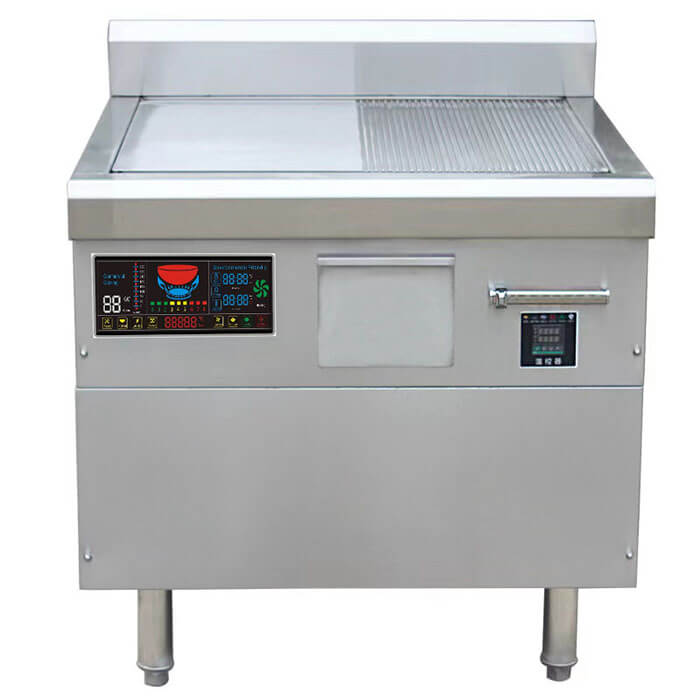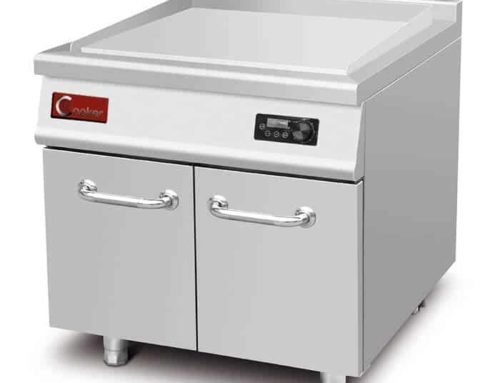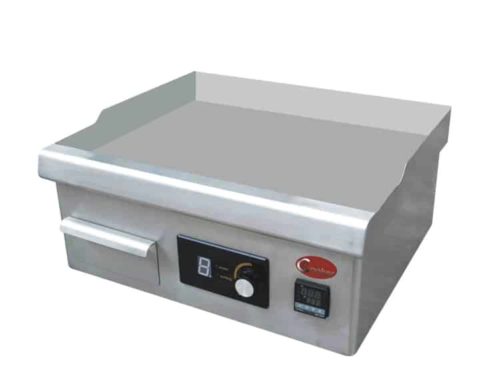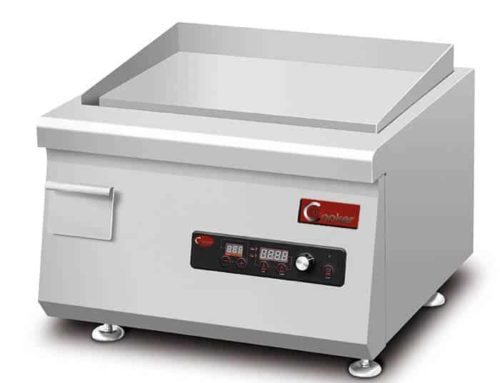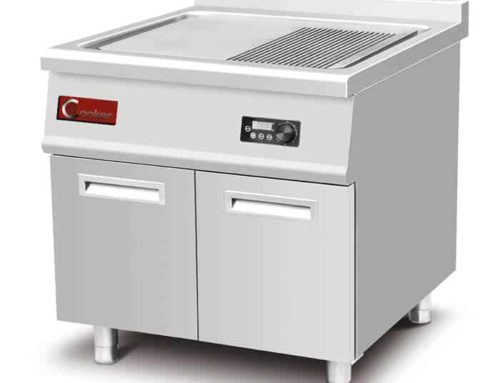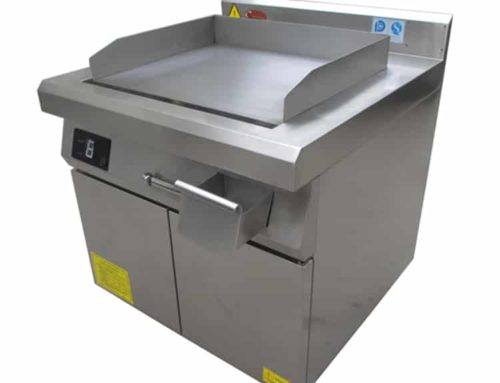Commercial Griddles Warranty: Typical Coverage, Terms & AT Cooker Policy
The typical warranty coverage for commercial griddles—including popular induction stove griddle models—ranges from 1 to 3 years, with coverage terms varying by brand, component, and usage conditions. Unlike residential griddles (which often have shorter, more limited warranties), commercial units require robust protection due to their 8–12 hours of daily use in high-pressure environments like restaurants, hotels, and catering facilities. For AT Cooker’s induction commercial griddle lineup, warranty coverage extends 1–3 years as standard, with optional extended plans, and is designed to minimize downtime for businesses by covering critical components and workmanship issues.
This comprehensive guide breaks down everything commercial kitchen operators need to know about griddle warranties: typical coverage durations, what parts are included (and excluded), how brand policies compare, how to maintain warranty validity, and why AT Cooker’s warranty stands out for reliability and customer support. We’ll also include real-world examples of how warranty coverage has protected businesses from unexpected repair costs, along with detailed tables to simplify comparing policies. By the end, you’ll be able to confidently evaluate warranty terms when purchasing a commercial griddle—whether it’s an induction cooktop griddle, cast iron griddle for induction cooktop, or any other commercial-grade model.
Covers: Manufacturing Defects, Electrical Parts
Excludes: Wear & Tear, Misuse
AT Cooker: 1–3 Years + Extended Options
Commercial > Residential (Robustness)
1. Typical Warranty Duration for Commercial Griddles
Warranty length for commercial griddles is primarily determined by two factors: the brand’s confidence in its product durability and the griddle’s intended use (light vs. heavy commercial). While residential griddles may offer 6 months to 1 year of coverage, commercial models—built to withstand rigorous use—generally come with 1 to 3 years of warranty protection. Below is a detailed breakdown of the typical duration ranges and what they mean for different business types:
1.1 Entry-Level Commercial Griddles: 1-Year Warranty
Entry-level commercial griddles—often used in small cafes, food trucks, or low-volume operations—typically come with a 1-year warranty. These models are often lighter-duty (e.g., thinner griddle plates, lower-wattage heating elements) and are priced competitively. A 1-year warranty covers basic manufacturing defects but may have more restrictions on labor or parts replacement.
For example, a budget 3.5KW induction griddle pan designed for food trucks might include a 1-year warranty that covers the induction coil and control panel but requires the customer to pay for shipping of replacement parts. While this is sufficient for businesses with low daily use, it can be risky for high-volume operations where downtime costs more than the savings from a cheaper griddle.
A food truck operator in Florida shared: “I bought a budget commercial griddle with a 1-year warranty. When the control panel failed 11 months in, the warranty covered the part—but I had to pay $80 for shipping and wait a week for it to arrive. We lost $500 in sales that week because we couldn’t cook our signature hash browns.”
1.2 Mid-Range Commercial Griddles: 2-Year Warranty
Mid-range commercial griddles—used in medium-volume operations like diners, boutique hotels, and catering companies—most commonly offer a 2-year warranty. These models balance durability and cost, with thicker plates, more robust electrical components, and better build quality than entry-level options. A 2-year warranty typically covers both parts and labor for manufacturing defects, reducing the financial burden on businesses.
AT Cooker’s 3.5KW countertop induction griddle (model AT-SS-G08), a mid-range option popular with diners, comes with a standard 2-year warranty. This covers the induction coil, control board, heating elements, and workmanship issues, with AT Cooker covering shipping for replacement parts and providing local technician support in most regions. A diner owner in Texas said: “Our AT Cooker griddle’s control board failed after 18 months. The warranty covered the part and labor—we had a technician out the next day, and we didn’t lose any business.”
1.3 High-End/Heavy-Duty Commercial Griddles: 3-Year Warranty
High-end commercial griddles—designed for heavy-volume use in large restaurants, hotel buffets, and institutional kitchens (schools, hospitals)—come with a 3-year warranty as standard. These models feature premium materials (e.g., 12mm cast iron plates, industrial-grade induction modules) and are engineered to last 7+ years. A 3-year warranty reflects the manufacturer’s confidence in their product and provides long-term peace of mind for businesses with constant griddle use.
AT Cooker’s 5KW freestanding induction commercial griddle (model AT-CI-G12), built for heavy-duty use, includes a 3-year warranty. This covers all major components—induction coil, control system, griddle plate (against warping from manufacturing defects), and wiring—with 24/7 technical support and priority parts shipping. A hotel kitchen manager in California noted: “We use this griddle for 12 hours a day, 7 days a week, cooking 300+ portions of breakfast daily. The 3-year warranty means we don’t have to worry about unexpected repair costs for years—its been a game-changer for our budget planning.”
1.4 Extended Warranty Options
Most manufacturers, including AT Cooker, offer extended warranty plans for commercial griddles—typically extending coverage by 1–2 years for an additional fee (5–15% of the griddle’s purchase price). Extended warranties are particularly valuable for high-volume operations, as they cover the griddle during its peak usage years, when component wear is most likely to occur.
For example, AT Cooker’s extended warranty for its 5KW griddle costs $150 for 1 additional year (extending from 3 to 4 years) and $250 for 2 additional years (extending to 5 years). This includes the same coverage as the standard warranty, plus priority service (technician dispatch within 48 hours) and free preventive maintenance checks. A large restaurant chain using 10 AT Cooker griddles said: “We opted for the 2-year extended warranty on all our griddles. It cost us $2,500 upfront, but we’ve already saved $5,000 in repair costs in the first year—its a no-brainer for multi-unit operations.”
2. What’s Covered Under a Commercial Griddle Warranty?
Warranty coverage for commercial griddles focuses on defects that stem from manufacturing or workmanship, not normal use. While specific terms vary by brand, most policies cover the following components and issues. Below is a detailed breakdown of typical inclusions, with a focus on how they apply to induction stove griddle models (the most common type in modern commercial kitchens):
Component/IssueTypical CoverageRelevance to Induction GriddlesManufacturing DefectsFull coverage (parts + labor) for defects in materials or construction (e.g., faulty wiring, uneven plate casting).Critical for induction griddles, as faulty components can lead to uneven heating or complete failure.Electrical ComponentsCoverage for induction coils, control boards, thermostats, and wiring harnesses.The most expensive parts of an induction griddle—repair/replacement costs can exceed $500 without warranty.Heating Elements/Induction ModulesCoverage for failure due to manufacturing defects (not wear).Induction modules are the “heart” of the griddle—coverage ensures no-cost replacement if they fail prematurely.Griddle Plate (Warping/Cracking)Coverage for warping or cracking caused by manufacturing flaws (not misuse or overheating).Important for cast iron griddle for induction cooktop models, as plate replacement costs $300–$800.Control Panels & User InterfaceCoverage for unresponsive buttons, faulty displays, or software glitches.Essential for commercial use, as control panel failure halts griddle operation entirely.Workmanship IssuesCoverage for issues like loose hinges, faulty knobs, or poor sealing.Prevents minor issues from becoming major problems (e.g., a loose knob leading to accidental temperature changes).
2.1 Key Coverage Examples for AT Cooker Induction Griddles
AT Cooker’s warranty policy is tailored to the unique needs of induction commercial griddles, with coverage that aligns with the most critical components. For example:
- Induction Coil: Covered for 3 years on high-end models (e.g., AT-CI-G12). If the coil fails due to a manufacturing defect, AT Cooker ships a replacement coil within 48 hours and covers the cost of a local technician to install it.
- Griddle Plate: Covered for 2 years against warping or cracking from defects. For a 10mm stainless steel plate, this saves businesses $400–$600 in replacement costs.
- Control Board: Covered for the full warranty term (1–3 years). A faulty control board on a 5KW griddle can cost $350 to replace—AT Cooker covers this in full, including labor.
A catering company using AT Cooker’s 3.5KW induction griddle shared: “Our induction coil failed after 2 years—right in the middle of wedding season. AT Cooker sent a replacement coil overnight and paid for a local tech to install it the next day. We didn’t miss a single event, and we didn’t pay a dime. That’s the kind of warranty support that keeps us loyal.”
2.2 Coverage for Specialty Griddles
Specialty commercial griddles—like double burner griddle for induction cooktop or induction non stick griddle models—have slightly different coverage terms due to their unique components:
- Double Burner Griddles: Warranty covers both induction modules/heating elements, as well as any synchronization issues between burners. AT Cooker’s double-burner model (AT-DB-G10) includes 2 years of coverage for both burners and their shared control system.
- Non-Stick Griddles: Non-stick coatings have shorter coverage (6 months to 1 year) due to their inherent wear. AT Cooker’s non-stick induction griddle covers the coating for 1 year against peeling from manufacturing defects (not scratches from utensils).
- Cast Iron Griddles: Coverage for cast iron plates extends 2–3 years against warping, as cast iron is more prone to manufacturing-related cracking than stainless steel. AT Cooker’s cast iron models include this extended plate coverage.
3. What’s NOT Covered Under a Commercial Griddle Warranty?
Equally important to understanding what’s covered is knowing what’s excluded from commercial griddle warranties. Most policies explicitly exclude damages or failures caused by factors outside the manufacturer’s control—typically related to misuse, normal wear, or improper maintenance. Below are the most common exclusions, along with examples of how they apply to real-world commercial kitchen scenarios:
3.1 Wear and Tear from Normal Use
Warranty policies do not cover deterioration from regular commercial use—this is considered the expected lifespan of components. Examples include:
- Scratches or discoloration on the griddle plate from daily use with spatulas or pans.
- Degradation of non-stick coatings from repeated cooking and cleaning (covered only if peeling is due to manufacturing defects).
- Loosening of knobs or handles from frequent adjustment (unless caused by poor workmanship).
For example, a line cook using a metal spatula on an induction non stick griddle may scratch the coating—this is excluded from warranty, as non-stick surfaces require silicone or wooden utensils. A café owner learned this the hard way: “I tried to claim warranty for a scratched non-stick plate, but the manufacturer said it was wear from metal utensils. I had to pay $200 for a new plate and switch to silicone tools.”
3.2 Misuse or Improper Operation
Failures caused by misuse—operating the griddle outside its intended parameters—are universally excluded. Common examples include:
- Overheating the griddle beyond its maximum temperature (e.g., setting a 450°F-max griddle to 600°F).
- Using incompatible cookware on induction griddles (e.g., non-magnetic pans that cause the induction module to overwork).
- Abusing the griddle (e.g., dropping heavy objects on the plate, using the griddle as a work surface).
A diner in New York had a claim denied when their induction griddle’s module failed after staff used aluminum pans (non-magnetic) for weeks. The manufacturer’s inspection found the module had burned out from overworking to detect compatible cookware—this was deemed misuse, so the repair ($600) was not covered.
3.3 Improper Installation or Maintenance
Warranties require griddles to be installed and maintained according to the manufacturer’s guidelines—failure to do so voids coverage. Examples include:
- Installing a 3-phase griddle on a single-phase power supply (causes electrical component failure).
- Neglecting to clean the griddle’s air vents (leads to overheating of induction modules).
- Using harsh chemicals (e.g., oven cleaner) on the griddle plate, which damages the surface or coating.
AT Cooker’s warranty explicitly requires professional installation for freestanding griddles. A hotel that installed a 5KW griddle themselves experienced a wiring failure—since the installation was not done by a certified technician, the warranty claim was denied, and the hotel paid $450 for repairs.
3.4 Environmental Factors and Accidents
Damages from environmental conditions or unforeseen accidents are excluded from warranty coverage:
- Water damage from floods or spills that seep into electrical components (unless caused by a manufacturing defect like poor sealing).
- Fire or smoke damage from kitchen fires.
- Theft or vandalism of components (e.g., stolen control knobs).
A food truck in a flood-prone area had their griddle’s control panel damaged by water—this was excluded from warranty, as it was an environmental factor. The owner had to pay $300 for a replacement panel.
3.5 Consumable Parts
Consumable parts—components designed to be replaced regularly—are not covered under warranty. These include:
- Grease trays or filters (need replacement every 6–12 months).
- Rubber gaskets or seals (deteriorate from heat and cleaning).
- Indicator lights or fuses (small, low-cost parts prone to burnout).
These parts are inexpensive ($10–$50 each) and easy to replace, so their exclusion is standard across all commercial griddle warranties.
AT Cooker’s Exclusion Clarification
AT Cooker’s warranty policy includes a “good faith” clause for borderline cases—for example, if a component fails due to a combination of minor maintenance oversight and a manufacturing defect, the company may cover a portion of the repair cost. A restaurant owner shared: “Our griddle’s induction module failed after we missed a cleaning cycle. AT Cooker’s technician determined the module had a manufacturing flaw that was exacerbated by dust buildup—they covered 70% of the repair cost, even though maintenance was a factor. That level of flexibility is rare in warranty policies.”
4. Commercial Griddle Warranty Comparison: Top Brands vs. AT Cooker
Warranty terms vary significantly by brand, with differences in duration, coverage scope, and customer support. To help you evaluate your options, below is a detailed comparison of warranty policies from leading commercial griddle manufacturers—including AT Cooker, Groen, Vulcan, and Garland—focusing on key factors like coverage length, parts included, labor coverage, and extended warranty options:
BrandStandard Warranty DurationCovered PartsLabor CoverageExtended Warranty OptionsKey AdvantageAT Cooker1–3 years (1 year entry-level, 2 years mid-range, 3 years high-end)Induction coils, control boards, griddle plates, wiring, workmanshipCovers labor for first 2 years; 50% coverage for year 31–2 years extension (5–15% of purchase price)Priority parts shipping, good faith clause for borderline claimsGroen2–3 yearsHeating elements, control systems, plate (2 years only)Covers labor for full term1–2 years extension (10–20% of purchase price)Global service network, lifetime technical supportVulcan1–2 yearsElectrical components, induction modulesCovers labor for 1 year; no coverage for year 21 year extension (15% of purchase price)Fast on-site service (48-hour dispatch)Garland1–2 yearsControl panels, heating elements, workmanshipNo labor coverage (parts only)1 year extension (12% of purchase price)Low-cost extended plansTramontina1 yearMajor electrical components onlyNo labor coverageNo extended optionsBudget-friendly purchase price
4.1 AT Cooker’s Competitive Edge
Compared to other brands, AT Cooker’s warranty stands out for three key reasons:
- Tiered Coverage for Different Needs: Unlike brands that offer a one-size-fits-all warranty, AT Cooker’s 1–3 year tiered system lets businesses choose coverage that matches their volume and budget. Small cafes can opt for entry-level 1-year coverage, while large hotels can select high-end 3-year coverage.
- Balanced Labor Coverage: Most brands either cover labor for the full term (high cost) or not at all (high risk for businesses). AT Cooker covers labor for 2 years and 50% for year 3, striking a balance that reduces business costs without sacrificing support.
- Customer-Centric Support: AT Cooker’s warranty includes 24/7 technical support, priority parts shipping (48-hour delivery in most regions), and a good faith clause for borderline claims—features that minimize downtime for commercial operations. A multi-location restaurant owner said: “We use both AT Cooker and Vulcan griddles. When a griddle fails, AT Cooker’s support team responds in hours, while Vulcan takes days. The difference in downtime costs is massive.”
4.2 Real-World Cost Savings with AT Cooker’s Warranty
To illustrate the financial impact of warranty coverage, consider two scenarios for a 5KW commercial induction griddle:
- Scenario 1: AT Cooker Griddle (3-Year Warranty): After 2.5 years, the induction module fails. AT Cooker covers the $500 module cost and 50% of the $200 labor cost—total business cost: $100. Downtime: 48 hours (priority parts shipping).
- Scenario 2: Budget Brand Griddle (1-Year Warranty): After 2.5 years, the induction module fails. The warranty expired 1.5 years prior—total business cost: $700 ($500 module + $200 labor). Downtime: 1 week (standard parts shipping).
The difference in cost is $600, plus the opportunity cost of lost sales during downtime. For high-volume restaurants, this can mean a loss of $1,000+ in sales per day of downtime—making AT Cooker’s warranty a significant financial safeguard.
“We switched all our griddles to AT Cooker 3 years ago, and their warranty has saved us thousands. Last year, two of our 5KW griddles had control board failures—AT Cooker covered the parts and labor for both, and we had technicians on-site within 2 days. With our old brand, we would have paid $1,200 for those repairs and been down for a week. The warranty alone justifies the slightly higher purchase price.”
5. How to Maintain Warranty Validity for Your Commercial Griddle
Having a robust warranty is only valuable if you maintain its validity. Most manufacturers void warranties if businesses fail to follow installation, operation, or maintenance guidelines. Below is a step-by-step guide to ensuring your commercial griddle’s warranty remains active, with specific tips for induction stove griddle models:
5.1 Follow Proper Installation Guidelines
Improper installation is one of the most common reasons warranty claims are denied. To avoid this:
- Hire a Certified Technician: For freestanding or high-power griddles (5KW+), always use a certified electrician or manufacturer-approved installer. AT Cooker provides a list of certified installers in each region and requires installation receipts for warranty claims.
- Verify Power Supply Compatibility: Ensure the griddle’s voltage requirements match your kitchen’s power supply (e.g., 3-phase 380V for heavy-duty models). Using the wrong power supply damages electrical components and voids warranty.
- Maintain Installation Records: Keep receipts, photos, and technician contact information for installation—manufacturers may request these to validate claims.
A bakery that installed an AT Cooker 3.5KW griddle themselves had a claim denied when the wiring failed. They later hired a certified technician to reinstall the replacement griddle and kept the receipt—when a different component failed 6 months later, the claim was approved.
5.2 Adhere to Operation Guidelines
Operating the griddle within its intended parameters is critical for warranty validity:
- Do Not Exceed Maximum Temperature: Most commercial induction griddles have a maximum temperature of 450–500°F. Exceeding this damages the plate and induction module.
- Use Compatible Cookware: For induction griddles, use only magnetic cookware (cast iron, 304# stainless steel). Non-magnetic cookware causes the induction module to overwork and fail.
- Avoid Abusive Use: Do not drop heavy objects on the plate, use the griddle as a cutting surface, or hit the control panel with utensils.
AT Cooker’s user manual includes a “quick reference” guide for proper operation, with icons and simple instructions to help staff avoid mistakes. A café owner said: “We post the quick reference guide next to each griddle—new staff can follow it easily, and we haven’t had any warranty issues due to misuse.”
5.3 Perform Regular Maintenance
Neglecting maintenance is another common warranty claim denial reason. Follow these maintenance steps:
- Daily Cleaning: Wipe the griddle plate with a damp cloth and mild detergent after each shift. Avoid harsh chemicals (e.g., oven cleaner) that damage the surface or coating.
- Weekly Deep Cleaning: Remove the griddle plate (if removable) and clean under it to remove grease buildup. Clean air vents to prevent overheating.
- Monthly Inspections: Check for loose wires, damaged knobs, or signs of wear. Tighten loose components and replace small parts (e.g., indicator lights) as needed.
- Keep Maintenance Logs: Document cleaning and inspections with dates, staff names, and photos. Manufacturers may request these to prove proper maintenance.
AT Cooker offers free maintenance checklists for download on their website, tailored to each griddle model. A hotel kitchen manager said: “We use the checklist to train staff and keep logs. When we had a warranty claim last year, the logs helped prove we’d maintained the griddle properly— the claim was approved within 24 hours.”
5.4 Keep Proof of Purchase and Warranty Documents
Without proof of purchase, manufacturers cannot verify warranty eligibility. Keep these documents in a safe place:
- Original purchase receipt (showing date, model number, and seller information).
- Warranty certificate (provided by the manufacturer or seller).
- User manual (with registration card filled out, if required).
Many brands, including AT Cooker, offer online warranty registration—registering your griddle within 30 days of purchase simplifies claims processing. A diner owner said: “I registered my AT Cooker griddle online the day I bought it. When I needed to file a claim 2 years later, I just logged into my account—they had all my purchase and model info on file, and the claim was processed in a day.”
6. AT Cooker’s Warranty Claim Process: Simple and Fast for Commercial Users
AT Cooker designed its warranty claim process to minimize downtime for commercial kitchens—recognizing that every hour a griddle is out of service costs businesses money. The process is streamlined into 4 simple steps, with dedicated support for commercial customers:
Step 1: Contact AT Cooker’s Commercial Support Team
Commercial customers can contact AT Cooker’s support team 24/7 via phone, email, or online chat. To speed up the process, have the following information ready:
- Griddle model number and serial number (located on the back of the unit).
- Date of purchase and proof of purchase (receipt or order number).
- Description of the issue (e.g., “induction module not heating,” “control panel unresponsive”).
- Photos or videos of the issue (if possible).
AT Cooker’s commercial support team is trained to prioritize high-volume operations—restaurants cooking 200+ portions daily receive priority response (within 1 hour), while smaller businesses receive a response within 4 hours. A catering company said: “We called AT Cooker at 2 AM when our griddle failed before a morning event. They answered immediately and walked us through troubleshooting—we got the griddle working temporarily, and a technician arrived with a replacement part at 8 AM.”
Step 2: Troubleshooting and Diagnosis
In many cases, the support team can resolve minor issues via phone or video chat—avoiding the need for a technician visit. Common troubleshooting steps include:
- Checking power supply and wiring connections.
- Resetting the griddle’s circuit breaker or control panel.
- Cleaning air vents or sensors to resolve overheating issues.
If the issue cannot be resolved remotely, the support team will schedule a technician visit or arrange for parts shipping. For critical components (e.g., induction modules), AT Cooker ships replacement parts via overnight delivery to minimize downtime.
Step 3: Repair or Replacement
Depending on the issue and warranty coverage:
- On-Site Repair: A certified technician visits the kitchen to repair the griddle. For covered issues, labor and parts are free (per warranty terms).
- Parts Replacement: For simple repairs (e.g., control knob replacement), AT Cooker ships the part with installation instructions. In-house staff can install it, or a technician can be dispatched for an additional fee (waived for high-end models).
- Griddle Replacement: If the griddle cannot be repaired (e.g., major plate warping), AT Cooker replaces it with a new unit of the same model—often within 48 hours for in-stock items.
A hotel in Las Vegas had their griddle replaced within 2 days after a manufacturing defect caused the plate to crack. The replacement was delivered and installed by a technician during the hotel’s off-hours, so breakfast service was not disrupted.
Step 4: Follow-Up and Documentation
After the repair or replacement, AT Cooker’s support team follows up within 48 hours to ensure the griddle is working properly. They also provide a detailed report of the issue and resolution, which can be stored with maintenance logs for future reference.
A restaurant owner said: “AT Cooker followed up a week after repairing our griddle to make sure everything was still working. They even sent us a free maintenance kit as a thank-you. It’s clear they care about keeping commercial kitchens running smoothly.”
7. Conclusion: Why Warranty Coverage Matters for Commercial Griddles
For commercial kitchen operators, a commercial griddle’s warranty is more than just a safety net—it’s a strategic investment in minimizing downtime, controlling costs, and ensuring consistent operations. The typical 1–3 year coverage for commercial griddles protects against unexpected repair costs for critical components like induction modules, control boards, and griddle plates—costs that can range from $300 to $1,000 without warranty.
AT Cooker’s warranty policy stands out in the industry for its tiered coverage (matching different business needs), balanced labor coverage, fast claim processing, and customer-centric support. Whether you’re a small café using a 3.5KW induction cookware griddle or a large hotel using a 5KW cast iron induction griddle, AT Cooker’s warranty is designed to keep your kitchen running without interruption.
When evaluating commercial griddle warranties, always look beyond the duration—consider what parts are covered, whether labor is included, how easy the claim process is, and if extended options are available. By choosing a griddle with a robust warranty like AT Cooker’s, you’ll protect your business from financial risk and focus on what matters most: serving high-quality food to your customers.
Get AT Cooker Commercial Griddle Warranty Details
Share your business type (e.g., “diner,” “hotel buffet”) and griddle model interest, and we’ll send you a customized warranty guide—including coverage terms, claim process details, and extended warranty pricing for your specific needs.
